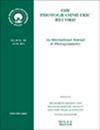摄影测量和扫描电子显微镜
IF 2.1
3区 地球科学
Q2 GEOGRAPHY, PHYSICAL
引用次数: 11
摘要
扫描电子显微镜形成位于真空标本室的物体表面的图像。一束精细的电子束与阴极射线管同步扫描表面,阴极射线管的光斑亮度由从样品发出的二次电子信号调制。该系统能够提供大的聚焦深度,从而允许通过在连续曝光之间倾斜样品来拍摄样品的不同投影。根据投影几何的知识(投影是中心或透视,但对于高倍图像,可以合理地视为平行或正交的情况),因此可以从视差的测量进行三维分析。本文的第一部分讨论了由于试件台和绘图仪器的机械设计限制而导致的实际问题,以及图像畸变的性质和来源。第二部分讨论了成功的绘图仪器的实际特点,这些仪器是专门为解决一个标准化的扫描电子显微镜问题而设计的,在这个问题中,一个立体图像对的两个成员的放大倍率保持不变。投影的外围“射线”与中心“射线”的发散角被假定为可以忽略不计(这是高放大图像的情况),两个标本姿态之间的倾斜角差是恒定的。本文章由计算机程序翻译,如有差异,请以英文原文为准。
PHOTOGRAMMETRY AND THE SCANNING ELECTRON MICROSCOPE
The scanning electron microscope forms images of the surfaces of objects located in a vacuum specimen chamber. A fine beam of electrons scans the surface in synchronism with a cathode ray tube whose spot brightness is modulated by the secondary electron signal emanating from the specimen. The system is capable of giving a large depth of focus and thus allows different projections of the specimen to be photographed by tilting the specimen between successive exposures. From a knowledge of the geometry of the projection (which is central or perspective, but may be justifiably treated as a parallel or orthogonal case for high magnification images), it is therefore possible to proceed to three dimensional analyses from the measurement of parallaxes. Part I of this paper deals with the practical problems resulting from mechanical design limitations of specimen stages and plotting instruments, as well as the nature and sources of image distortions. Part II deals with the practical features of the successful plotting instruments designed especially for the solution of a standardised scanning electron microscope problem in which the magnification of the two members of a stereoscopic pair of images is held constant, the angle of divergence of the peripheral “rays” of the projection from the central “ray” is assumed to be negligible (which is the case for high magnification images) and the tilt angle difference between the two specimen attitudes is constant.
求助全文
通过发布文献求助,成功后即可免费获取论文全文。
去求助
来源期刊

Photogrammetric Record
地学-成像科学与照相技术
CiteScore
3.60
自引率
25.00%
发文量
71
审稿时长
>12 weeks
期刊介绍:
The Photogrammetric Record is an international journal containing original, independently and rapidly refereed articles that reflect modern advancements in photogrammetry, 3D imaging, computer vision, and other related non-contact fields. All aspects of the measurement workflow are relevant, from sensor characterisation and modelling, data acquisition, processing algorithms and product generation, to novel applications. The journal provides a record of new research which will contribute both to the advancement of photogrammetric knowledge and to the application of techniques in novel ways. It also seeks to stimulate debate though correspondence, and carries reviews of recent literature from the wider geomatics discipline.
Relevant topics include, but are not restricted to:
- Photogrammetric sensor calibration and characterisation
- Laser scanning (lidar)
- Image and 3D sensor technology (e.g. range cameras, natural user interface systems)
- Photogrammetric aspects of image processing (e.g. radiometric methods, feature extraction, image matching and scene classification)
- Mobile mapping and unmanned vehicular systems (UVS; UAVs)
- Registration and orientation
- Data fusion and integration of 3D and 2D datasets
- Point cloud processing
- 3D modelling and reconstruction
- Algorithms and novel software
- Visualisation and virtual reality
- Terrain/object modelling and photogrammetric product generation
- Geometric sensor models
- Databases and structures for imaging and 3D modelling
- Standards and best practice for data acquisition and storage
- Change detection and monitoring, and sequence analysis
 求助内容:
求助内容: 应助结果提醒方式:
应助结果提醒方式:


